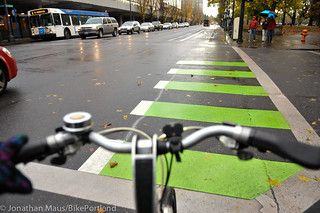As PBOT puts the finishing touches on the (on-street) changes to NE Multnomah in the Lloyd District, a few questions have popped up in my head and in my inbox. What’s with the buffer zone? And why the yellow-ish color? Why isn’t the protected bike lane space painted green?
I put these questions to PBOT recently and they’ve responded with some background that’s worth sharing.
“PBOT looked at earth tones for Multnomah and decided on a color called “beeswax.” This shade of beige contrasts well with wet asphalt and the City of Portland flags that were painted throughout the streetscape.”
— Dan Anderson, PBOT spokesman
First, for the record, the official color of the buffer zone is “beeswax” (not ecru as some of you were calling it). That’s according to PBOT spokesman Dan Anderson. He says PBOT considered various “earth tones” for the project and ultimately settled on the shade of beige known as beeswax because it, “contrasts well with wet asphalt and the City of Portland flags that were painted throughout the streetscape.”
As for why they painted the buffer (and have recently added large potted plants to it), Anderson says it was done to “scale down the streetscape from a wide expanse of pavement meant to move cars to a more approachable street where both people and cars can move safely and efficiently.” In addition to the traffic calming impacts, the paint also lets folks know they shouldn’t drive or park on it.
This is the first painted buffer zone with planters and decorations anywhere in Portland. Where’d the inspiration come from? Why New York City of course — the leaders in reclaiming roadway space. Anderson said PBOT has taken note of New York City’s success using paint to “create spaces out of excess roadway.” “Because the painted buffer is a new edition to our traffic engineering toolkit,” adds Anderson, “we’ll monitor its success and make changes as needed.”
What about the bike lane? Most of the protected lanes in New York City and elsewhere are painted green. There’s even a national program to spur development of protected bike lanes and it’s called the Green Lane Project. So, why aren’t the bike lanes on Multnomah painted green?
Anderson says using green paint is just one tool in their “traffic engineering toolkit” that they use to distinguish bikeways from standard lanes. The bikeways on NE Multnomah are not painted green (except at certain conflict areas), says Anderson, “Because we don’t feel there’s confusion that the space is for people on bikes.”
“The tan-painted buffers with wands and planters and width of the bikeway make it clear that it is not a space for drivers. This distinguishes issues there, for example, from the green lanes on SW Stark and SW Oak.”
There was some initial confusion with people riding in the buffer zone and others not really understanding what was going on. Now with the planters and other features installed, my hunch is that things are working more smoothly (although I won’t be surprised to read a story from the local media about how terrible and confusing the new design is). Anderson said if they start seeing confusion, they’ll consider painting the bikeway.
Are you riding or driving on NE Multnomah? If so, how is it working for you? What are you seeing out there?



